凤凰职教新课程英语第一册Unit3-western table manners教学提纲
- 格式:ppt
- 大小:5.01 MB
- 文档页数:22
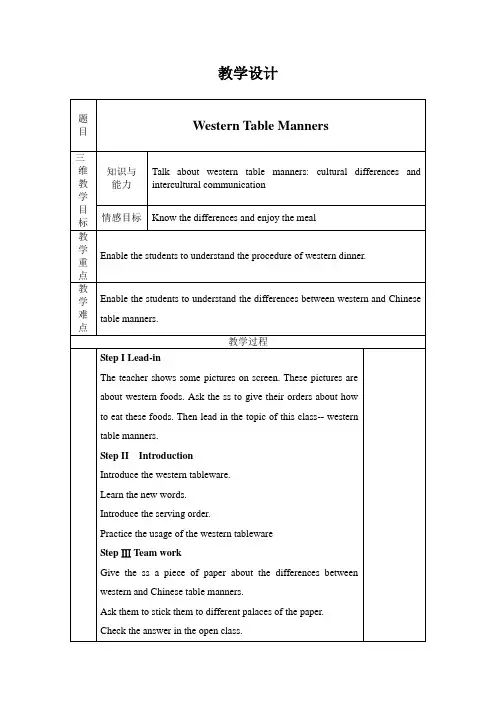
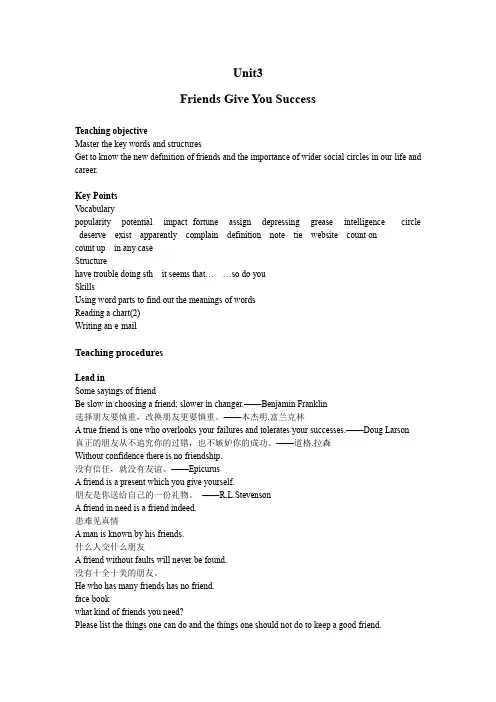
Unit3Friends Give You SuccessTeaching objectiveMaster the key words and structuresGet to know the new definition of friends and the importance of wider social circles in our life and career.Key PointsV ocabularypopularity potential impact fortune assign depressing grease intelligence circle deserve exist apparently complain definition note tie website count oncount up in any caseStructurehave trouble doing sth it seems that… …so do youSkillsUsing word parts to find out the meanings of wordsReading a chart(2)Writing an e-mailTeaching proceduresLead inSome sayings of friendBe slow in choosing a friend; slower in changer.——Benjamin Franklin选择朋友要慎重,改换朋友更要慎重。
——本杰明.富兰克林A true friend is one who overlooks your failures and tolerates your successes.——Doug Larson真正的朋友从不追究你的过错,也不嫉妒你的成功。
——道格.拉森Without confidence there is no friendship.没有信任,就没有友谊。
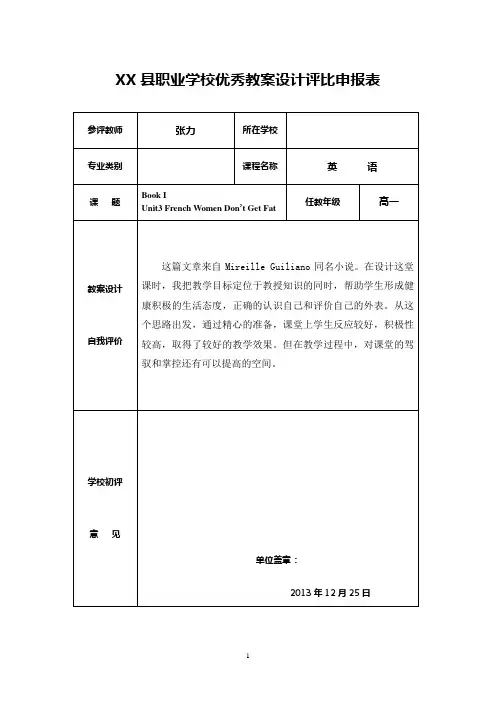
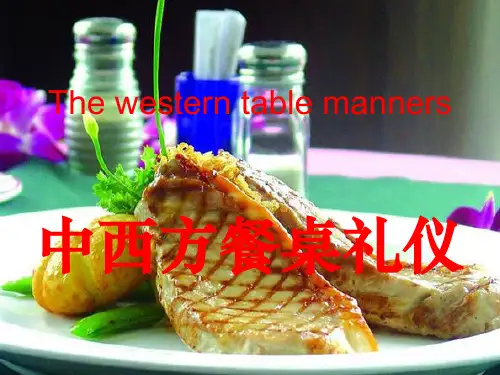
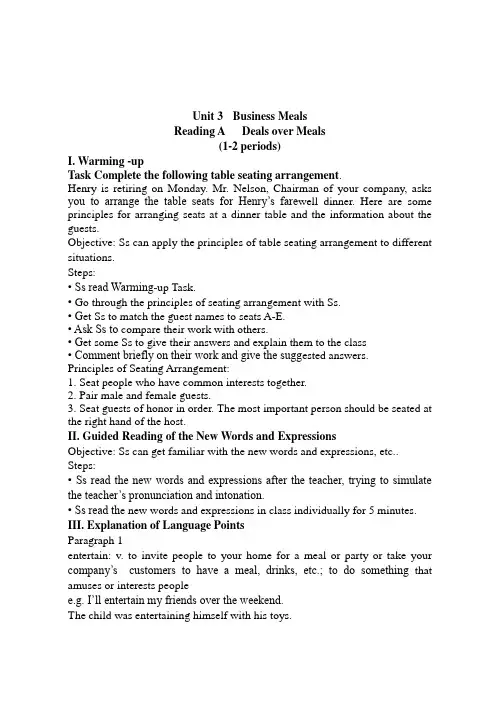
Unit 3 Business MealsReading A Deals over Meals(1-2 periods)I. Warming -upTask Complete the following table seating arrangement.Henry is retiring on Monday. Mr. Nelson, Chairman of your company, asks you to arrange the table seats for Henry’s fare well dinner. Here are some principles for arranging seats at a dinner table and the information about the guests.Objective: Ss can apply the principles of table seating arrangement to different situations.Steps:• Ss read Warming-up Task.• Go through the principles of seating arrangement with Ss.• G et Ss to match the guest names to seats A-E.• Ask Ss to compare their work with others.• G et some Ss to give their answers and explain them to the class• Comment briefly on their work and give the sugg ested answers.Principles of Seating Arrangement:1. Seat people who have common interests together.2. Pair male and female guests.3. Seat guests of honor in order. The most important person should be seated at the right hand of the host.II. Guided Reading of the New Words and ExpressionsObjective: Ss can get familiar with the new words and expressions, etc.. Steps:• Ss read the new words and expressions after the teacher, trying to simulate the teacher’s pronunciation and intonation.• Ss read th e new words and expressions in class individually for 5 minutes. III. Explanation of Language PointsParagraph 1entertain: v. to invite people to your home for a meal or party or take your company’s customers to have a meal, drinks, etc.; to do something that amuses or interests peoplee.g. I’ll entertain my friends over the weekend.The child was entertaining himself with his toys.build up: to build; to increase, or become bigger or stronger graduallye.g. They have built up a good reputation.Th e noise built up until she couldn’t stand it any longer.formal: a. appropriate for official or serious situations or occasionse.g. I only wear this suit for formal dinners.Our boss is very formal; she doesn’t call anyone by their first name. Paragraph 2imply: v. to make something understood without expressing it directlye.g. I do not imply that you are wrong.urgency: n. something very important and needing to be dealt with immediatelye.g. Well, take it easy! It isn’t a matter of urgency.company: n. the state of being with someonee.g. Rita’s husband is away for the week, so I think I’d better go over and keep her company.Paragraph 3turn out: to have a particular result; to happen in a particular waye.g. That man we met turned out to be Maria’s second cousin.Don’t worry. I’m sure it will all turn out fine.pay: v. to bring a good result or advantage for someonee.g. It usually pays to tell the truth.be on one’s best behavior: to behave as well and politely as you can, esp ecially in order to please someonee.g. I want you to be on your best behavior at Granddad’s. knowledgeable: a. (of a person) knowing a lote.g. Dick is very knowledgeable about wines.see someone through (something): to help someone continue doing something, especially something difficult or unpleasant, until it is finishede.g. This overcoat has seen me through many severe winters.He saw me through all the hard times.intelligent: a. having a high level of mental ability; good at understanding ideas and thinking quickly and clearlye.g. All teachers regard Jimmy as an intelligent student.intelligently: ad. in an intelligent waye.g. You have to speak intelligently at this important business meeting. Paragraph 4come in handy: to be usefule.g. I’ll put these bottles in the cupboard —they might come in handy someday.conduct: v. to behave in a particular way, especially in a situation where people judge you by the way you behave; to carry oute.g. Public figures have a duty to conduct themselves responsibly.The company conducted a survey to find out what their customers think about the new product.concentrate (on): v. to think very carefully about something that you are doing e.g. She was concentrating on her book and didn’t know what had happened. Paragraph 5sought-after: a. wanted by a lot of peoplee.g. Doctors are the most sought-after people in the area.IV. Exercises• Ss do Task 1 and Task 2 individually.• Check the answers.V. Assignments1. Recite the new words and expressions.2. Pre-reading of Reading B.Unit 3 Business MealsReading B and Writing(3-4 periods)I. Background InformationDifferences between Chinese table manners and the Western table manners.1. ChopsticksChopsticks are used to eat most kinds of Chinese foods. Hold your chopsticks towards their end, not in the middle or the front when dining with them. When you are not using your chopsticks, or have finished eating, lay them down in front of you with the tips to left.2. NapkinAs soon as the hostess picks up her napkin, pick yours up and lay it on your lap.3. The Soup CourseDinner usually begins with soup. The largest spoon at your place is the soup spoon. It will be beside your plate at the right-hand side.4. The Fish CourseIf there is a fish course, it will probably follow the soup. There may be a special fork for the fish, or it may be similar to the meat fork. Often it is smaller.5. The Meat CourseThe main course is usually served by the host himself, especially if it is a fowl (鸡禽) or a roast which needs to be carved. He will often ask each guest what piece he prefers, and it is quite proper to state your preference as to lean or fat, dark (红肉) or light (白肉).6. Using Knife and ForkThe English keep the fork in the left hand, point curved downward, and bring the food to the mouth either by sticking the points onto it or in the case of soft vegetables, by placing it firmly on the fork in this position with the knife. Americans carve the meat in the same position, then lay down the knife and taking the fork in the right hand with the point turned up, push it under a small piece of food without the help of the knife and bring it to the mouth right-side-up.7. Helping Yourself and RefusingIf a servant passes food around, he will pass the dish at your left hand so that you can conveniently serve yourself with your right hand. Never serve yourself while the dish is on your right; it is then the turn of your neighbor on the right. It is polite to take some of everything that is passed to you. But if there is something you may not like, you may quietly say: "No, thank you." 8. Other Things on the TableWhen there are things on the middle of the table, such as bread, butter, jelly, pickles, nits, candies, you should not take any until the hostess has suggested that they be passed.9. Leaving the TableIt is impolite for a guest to leave the table during a meal, or before the hostess gives the signal at the end. When the hostess indicates that the dinner is over, she will start to rise from her seat and all the guests rise from theirs at the same time.II. Exercises• Ss do Task 1 and Task 2 on Page 39 in pairs.• Check the answers.III. Writing: Invitation邀请信是邀请亲朋好友或知名人士、专家等参加某项活动时所发出的请约性书信。

教案纸(教学环节一般包括复习旧课、导入新课、讲授新课、学生操作、教师点评、归纳总结、布置作业等)教案纸教案纸(教学环节一般包括复习旧课、导入新课、讲授新课、学生操作、教师点评、归纳总结、布置作业等)(教学环节一般包括复习旧课、导入新课、讲授新课、学生操作、教师点评、归纳总结、布置作业等)教案纸(教学环节一般包括复习旧课、导入新课、讲授新课、学生操作、教师点评、归纳总结、布置作业等)(教学环节一般包括复习旧课、导入新课、讲授新课、学生操作、教师点评、归纳总结、布置作业等)教案纸(教学环节一般包括复习旧课、导入新课、讲授新课、学生操作、教师点评、归纳总结、布置作业等)教案纸(教学环节一般包括复习旧课、导入新课、讲授新课、学生操作、教师点评、归纳总结、布置作业等)教案纸(教学环节一般包括复习旧课、导入新课、讲授新课、学生操作、教师点评、归纳总结、布置作业等)教案纸(教学环节一般包括复习旧课、导入新课、讲授新课、学生操作、教师点评、归纳总结、布置作业等(教学环节一般包括复习旧课、导入新课、讲授新课、学生操作、教师点评、归纳总结、布置作业等)教案纸(教学环节一般包括复习旧课、导入新课、讲授新课、学生操作、教师点评、归纳总结、布置作业等)教案纸(教学环节一般包括复习旧课、导入新课、讲授新课、学生操作、教师点评、归纳总结、布置作业等教案纸(教学环节一般包括复习旧课、导入新课、讲授新课、学生操作、教师点评、归纳总结、布置作业等)教案纸(教学环节一般包括复习旧课、导入新课、讲授新课、学生操作、教师点评、归纳总结、布置作业等)教案纸(教学环节一般包括复习旧课、导入新课、讲授新课、学生操作、教师点评、归纳总结、布置作业等)教案纸(教学环节一般包括复习旧课、导入新课、讲授新课、学生操作、教师点评、归纳总结、布置作业等)教案纸(教学环节一般包括复习旧课、导入新课、讲授新课、学生操作、教师点评、归纳总结、布置作业等)教案纸(教学环节一般包括复习旧课、导入新课、讲授新课、学生操作、教师点评、归纳总结、布置作业等)教案纸(教学环节一般包括复习旧课、导入新课、讲授新课、学生操作、教师点评、归纳总结、布置作业等)教案纸(教学环节一般包括复习旧课、导入新课、讲授新课、学生操作、教师点评、归纳总结、布置作业等)教案纸(教学环节一般包括复习旧课、导入新课、讲授新课、学生操作、教师点评、归纳总结、布置作业等)教案纸(教学环节一般包括复习旧课、导入新课、讲授新课、学生操作、教师点评、归纳总结、布置作业等)。

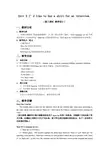
Unit 3 I’d like to buy a shirt for an interview.(第三课时教学设计)一、教材分析1.教学内容本课时系教材《英语基础教程》(1)第三单元的第三课时,包括Language in use中的语法部分,具体内容为:There be句型的基本用法,能用there be句型描述各种生活场景。
2.教学重点、难点⑴教学重点There be句型的基本用法。
⑵教学难点能用there be句型描述各种生活场景。
二、教学目标1.知识目标⑴学生掌握以下词汇和短语:cinema, wait a moment, teaching building, dormitory building.⑵学生能理解并掌握There be句型及其疑问、否定形式的用法:-There is/are…-There is/are not…-Is/Are there…?-Yes, there is/are.-No, there is/are not.2.能力目标(1) 学生能将there be句型变成否定式、疑问式及肯定和否定回答。
(2) 学生能用there be句型描述各种生活场景。
3.情感目标在学习中培养学生的礼貌举止,做事仔细的习惯。
三、教学步骤Step One Lead-inThe teacher plays a video for the students. Have all the students take some notes according to the video about sentence pattern “there be”. Show them the Chinese sentences before playing the video.(设计意图:播放的卡通小视频里面是关于there be句型一些表述,在视频下方均呈现了英文字幕。
在播放之前将中文句子写出来,便于学生抓住视频内容的重点。
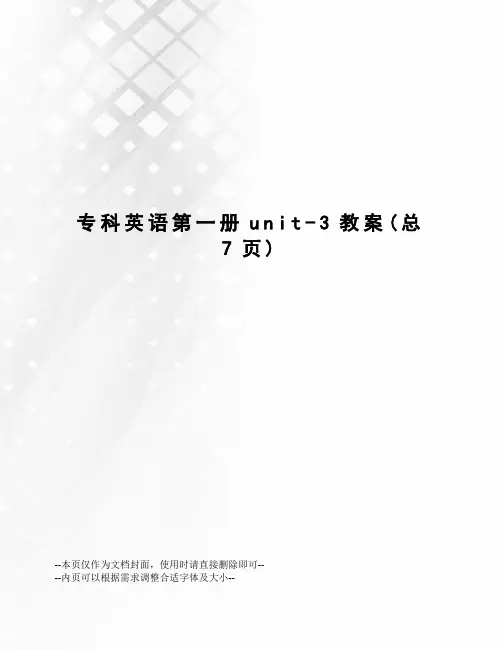
专科英语第一册u n i t-3教案(总7页)--本页仅作为文档封面,使用时请直接删除即可----内页可以根据需求调整合适字体及大小--Unit 3 fashion ShowTeaching material:English: Book 2Target audiences: Freshmen of non-English majorModule One Experiencing EnglishTeaching Objectives1.To arouse the students’ interests for the topic of this unit and participateactively2.Master the new words and expressions.3.Have a right attitude towards fashion.Teaching Emphasis & DifficultySpeak with logical thinking.Make and practice the topic-related dialogueImprove student s’ listening ability.Teaching ApproachesCommunicative method (question-answer and group discussion) ExemplificationTeaching Procedure1.Warm- upGood morning guys, nice to see you again. It’s a nice day right Before begin our class, let’s listen to a song.Lead-inAfter listening to the song, can you guess what topic we are going to talk? Fashion showWhen you think about fashion, what comes to mind?BESTSELLER GROUP (绫致时装)It is a Danish international fashion group, which is headquartered in Brande Denmark.Many young people always go into raptures at the merely mention of buying fashionable clothes.Q: Do you pay close attention to fashion?Do you mind you look unfashionable?Do you follow the trend of fashion every year?2.Focus on Speaking Task 1Work in pairs to practice the conversation below by filling in the missing part with the given expression.A: Do you think I still look fashionable in this dress?B: I think so. 1 .A: This style came out last year, though. 2 but I’ m not sure whether last year’s fashion will be the same this year.B: I think this kind of dress will stay in fashion for a few more years. People don’ t change fashionsevery year. 3 .A: Yes. Only the top designers try to tell people to change their fashion every year, 4 .B: There are some real fashion victims who just have to keep totally up-to-date with expensive clothes.A: 5 , but my budget simply doesn’t stretch that far. I have to limit the amount of money I spend on clothes, otherwise I would go on a shopping spree.B: 6 . The situation will be worse if we marry our boyfriends and have children. Then we’ll have even less money to spend on fashionable clothes!A. but only rich people can do itB. It would be too expensiveC. I wish I could be one of those peopleD. I know what you meanE. Blue is still very fashionable at the momentF. I like this dress3.Focus on Speaking Task 2As we all know fashion is closely related to our life, college students are enthusiasm about it. Do you think college students should follow fashion Please work in group and have a discussion with your group members, and then please make a conversation according to the cue cards given below.Cue Card ASituation: Two friends meet on the campus, and argue about whether students should follow fashion.Speaker A: You believe that following fashion means being able to adapt oneself to the changes.Tips for speaking● Exchange greetings.● Following fashion will be good for our personalities.● Society is progressing and one should adapt oneself to constant change.Cue Card BSituation: Two friends meet on the campus, and argue about whether students should follow fashion.Speaker B: You think it is not worth spending too much time and money on fashion.Tips for speaking● Exchange greetings.● Following fashion may adversely influence our study.● Fashion is a luxurious thing, so it may cause a lot of trouble in our economy. Sample DialogueA: Hello, long time no see. How are things going?B: Not bad. You got another new coat?A: Yes. What do you think about it?B: Nice. But I am surprised by your remarkable speed of getting new clothes.A: I am never tired of fashion.B: Is fashion really that important?A: Sure. Society is progressing and one should adapt oneself to constant change. Can you imagine it if everyone stuck to the old fashion There wouldn’t be any change and naturally there wouldn’t be progress.B: Of course, one should be flexible and adapt himself to the situation. However, seeking after fashion may occupy all your mind, especially for young girls. We might be unable to focus on study, which is really important. Besides, fashion is a luxurious thing.A: That’s true. But by following fashion, I mean making us suitably attractive instead of a lot ofexpenditure.B: Yes. We should consider whether fashion is favorable or unfavorable. Moreover, one should have one’s own characteristics.A: I agree. If everyone follows the same fashion, there will not be any variety and the whole society will be simple and dull.4.Focus on ListeningTask 1 Listen to the following sentences twice and fill in the missing words you hear in the recording.1. Since , the Federation has been using prestigious places located in the very heart of Paris to present the shows.2. Six talented designers displayed “nouvelle couture” in Shanghai Fashion Week.3. I don’ t think design is far behind the foreign brands.4. The designers have all showed great . in the Chinese market.5. The industry isn’t meeting the needs of modern Chinese women. Task 2 Listen to the following short conversations twice and choose the best answer to each question you hear in the recording.1.()A. A doctor. B. A barber.C. A salesman.D. A teacher.2.()A. A modern art exhibition.B. A classical art show.C. A handcrafts show.D. A book exhibition.3.()A. A dress. B. A pair of suits.C. Some children’s clothes.D. Some children’s toys.4.()A. The community college.B. The police station.C. The City Bank.D. The library.5.()A. The man went to see the musical.B. The man had his car broken down.C. The woman gave a ticket to the man.D. The woman brought a ticket for the man.Task 3 Listen to the short passage three times and fill in the blanks with the missing words you hear in the recording.Foreign 1 competing in the market have better 2 and brand images than those from China right now. But Chinese 3 have their own advantages. While foreign designers 4 to view China as a whole, Chinese designers recognize the differences in 5 around the country. The cultures and needs are very different as you 6 . Foreign 7 entering China can 8 localizing their brands, but Chinese designers are already there.SummaryIn this class, we have learned something about fashion and fashion show, and have a hot discussion on whether college students should follow fashion. To sum up, whether fashion is favorable or unfavorable, we should keep our own characteristics. I hope all of you can have an right attitude toward fashion. Assignment1.Review what we have learned in this class.2.Collect some related information about Chinese fashion designer andfashion show.3.Preview module Two.。
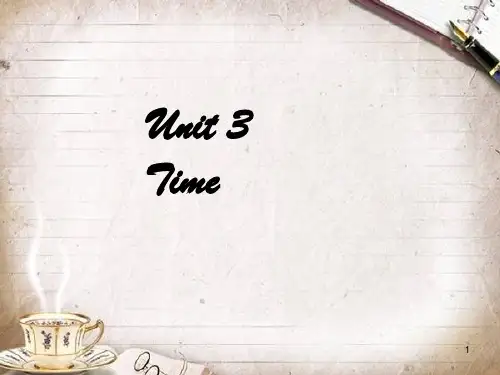
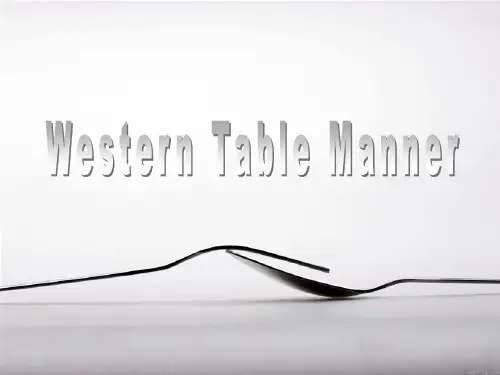
Unit 3 I’d like to buy a shirt for an interview.(第四课时教学设计)一、教材分析1.教学内容本课时系教材《英语基础教程》(1)第三单元的第四课时,包括V ocabulary practice和Supplementary reading两部分,具体内容为:要求学生能够熟练掌握本单元所学词汇、短语和语法,在拓展阅读部分,能够利用快速阅读、略读等方法,顺利完成阅读材料重要信息的提取。
2.教学重点、难点⑴教学重点掌握本单元所学词汇、短语和语法。
⑵教学难点掌握快速阅读、略读等学习策略,完成阅读材料重要信息的提取。
二、教学目标1.知识目标(1)通过动词的配对练习,用所给词的正确形式填空,巩固本单元的重点词汇和短语:suit, guarantee, quality, dairy, formal, wrap, life style, pay online, latest fashion, look perfect.(2)掌握拓展阅读中出现的新词汇、短语:backstage, celebrate, click, disappointed, erase, figures, generate, originally, satisfied, single, survey, touch, shopping spree.2.能力目标(1) 学生能够在具体练习中正确使用和操练本单元重点词汇和短语。
(2) 学生能够通过快速阅读、略读等学习策略,完成拓展阅读材料重要信息的提取。
3.情感目标(1) 在完成练习的过程中,感受到收获知识的成就感。
(2) 在网购时,注意保护隐私,不要泄露自己的个人信息。
三、教学步骤Step One Review and Lead-in1.Memory.It is a game, which exercises the power of memory. Two sets of same flashcards should be prepared (or use the ppt to play the game). Shuffle the cards and place them face down on the table. The students take turns and turn the cards over. If the cards are the same, they keep them; if they’re different, they have to turn them face down again. The student with the most pairs at the end is the game winner. (翻牌游戏是训练记忆力的最佳方法之一。
凤凰职教第一册各单元词组Unit 11. southern part of2. graduate from3. Jiangsu province4. family name5. spend … on…6. comic books7. go to the movies 8. Mobile phone bill 9. send text message10. Save up11. a favorite singer 12. E-mail account 13. student identity card 14. Date of birth 15. got it 16. School subject17. public transportation system18. 40 percent of my classmates19. have forgotten the password20. gender differenceUnit 21. training center2. Dinning hall3. teachers’ office4. Classroom building5. take a writing course6. Computer science7. customer service8. Radio station9. tennis club 10. After-school activities 11. various interesting subjects 12. At heart 13. be born to be 14. Deal with the problem15. opening hours 16. From now on17. the coming interview18. Increase one’s confidence19. what’s more 20. More and moreUnit 31. eating habit2. Stand in line3. go to the gym4. Contain high calories5. make good use of6. Lead to7. make wise choice 8. In a convenient way9. main course 10. At a time11. most of the time 12. A piece of furniture 13. make much progress 14. Take a look 15. be ready to order 16. Expensive chocolate 17. seldom skip breakfast 18. Fast food19. fruit and vegetables 20. A cooking recipeUnit 41. play chess2. Take photos3. play the piano4. Spare time5. nothing special6. Be good in sth.7. be crazy about 8. In full bloom9. be worth every penny 10. All summer long 11. well into fall12. can’t stand sth.13. full-time student 14. Future generation 15. protect the wildlife 16. School clubs17. once or twice a week 18. In early spring19. at the beginning of December20. talk for hoursUnit 5 1. Play badminton 2. Tennis racket 3. sportswear and sneakers 4. Get excited about 5. sports field 6. Take place7. colored flag 8. Take part in9. win second place 10. Three-legged race 11. come in fifth12. Cheer for sb.13. all the time 14. Special guests15. among those popular sports16. sigh up for the events 17. Bar chart18. Youth Olympic Games 19. Open ceremony 20. Chinese tradition and cultureUnit 61. ask for/ give directions2. hang out3. go straight on4. nursery school5. be tired of6. a lively and noisy city7. hurt one’s feelings8. high quality work9. shopping mall10. tourist attractions11. electronic products12. fashionable things13. all sorts of14. homemade sandwiches15. invite ab. Over16. student discount17. lay stress on18. background music19. achieve one’s goal20. slow down at the crossroad1. give advice on sth.2. have a sore throat3. learn from the mistake4. low-fat meal5. take crowded train6. drink alcohol7. stay active 8. take the elevator9. work long hours 10. outdoor activities 11. lead a healthy life 12. lo se some weight 13. control one’s diet 14. get treatment15. a health check-up 16. blood pressure17. be allergic to 18. a sense of achievement 19. work to a deadline 20. for decades1. digital products2. Send an e-mail3. favorite website4. Search engine5. the rapid growth of …6. Over recent years7. despite this8. Make cheating easier9. give a PowerPoint presentation10. social skills 11. Design a poster12. log onto 13. Confirm the order14. payment method 15. Cash on delivery 16. read through 17. Work on a new project 18. credit card 19. A wide range of choices20. pretend to be an adult21. along with three other colleagues22. walk no fast than a tortoise23. pass the examination24. the concert of his favorite star25. you must be kiddingUnit 91. celebrate a festival2. check a calendar3. a bunch of pictures4. bright sunshine5. Father Christmas6. wake up to7. major cause of the problem8. receive an invitation9. be supposed to do sth.10. make sb. relaxed11. have two weeks off12. break one’s leg 13. ask sb. for permission 14. wear sports shoes15. express one’s congratulations on sth.16. come across sb.17. enrich oneself with knowledge and experience18. in my opinion 19. fall in ( month/ season) 20. take some medicineUnit 101. make wise decisions2. have a job interview3. see eye to eye on sth.4. buy a used laptop5. use up one’s savings6. pay the rent7. sign an agreement8. post an add on ..9. more job opportunities10. persuade sb. into doing sth.。